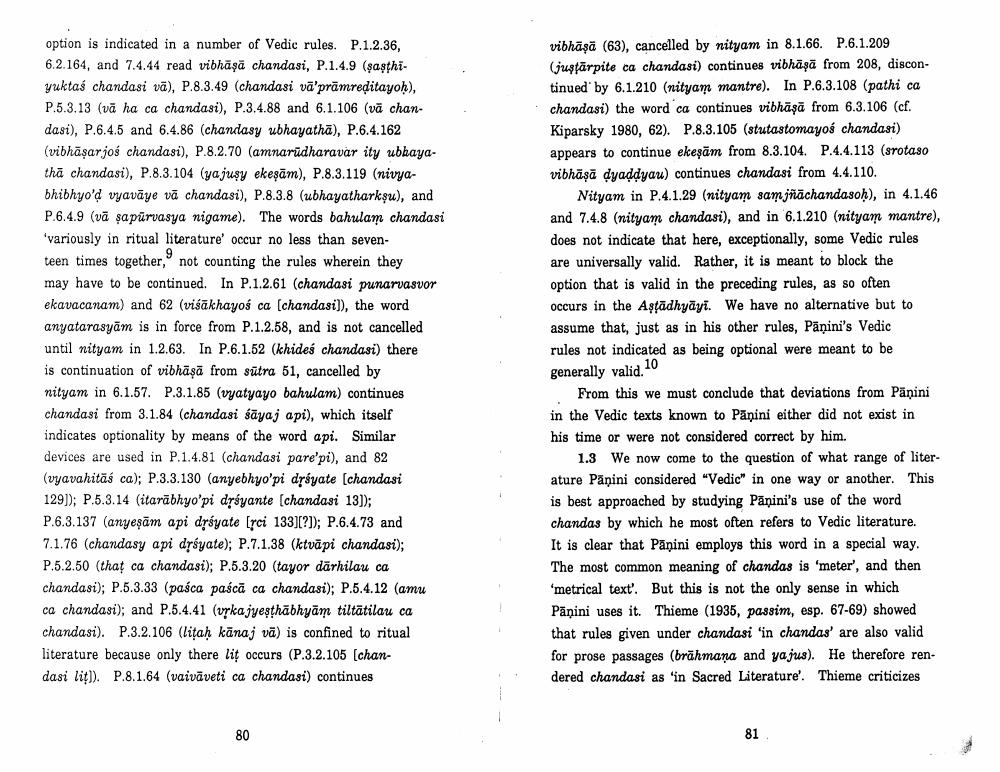Book Title: Paninian And Veda Reconsidered Author(s): Johannes Bronkhorst Publisher: Johannes Bronkhorst View full book textPage 4
________________ option is indicated in a number of Vedic rules. P.1.2.36, 6.2.164, and 7.4.44 read vibhāşa chandasi, P.1.4.9 (sasthiyuktas chandasi vä), P.8.3.49 (chandasi vä'prämreḍitayoḥ), P.5.3.13 (va ha ca chandasi), P.3.4.88 and 6.1.106 (vā chandasi), P.6.4.5 and 6.4.86 (chandasy ubhayatha), P.6.4.162 (vibhāṣarjoś chandasi), P.8.2.70 (amnarudharavar ity ubhayatha chandasi), P.8.3.104 (yajusy ekeṣām), P.8.3.119 (nivyabhibhyo'ḍ vyavāye va chandasi), P.8.3.8 (ubhayatharksu), and P.6.4.9 (vā ṣapūrvasya nigame). The words bahulam chandasi 'variously in ritual literature' occur no less than seventeen times together, not counting the rules wherein they may have to be continued. In P.1.2.61 (chandasi punarvasvor ekavacanam) and 62 (visakhayoś ca [chandasi]), the word anyatarasyām is in force from P.1.2.58, and is not cancelled until nityam in 1.2.63. In P.6.1.52 (khides chandasi) there is continuation of vibhāṣā from sutra 51, cancelled by nityam in 6.1.57. P.3.1.85 (vyatyayo bahulam) continues chandasi from 3.1.84 (chandasi sayaj api), which itself indicates optionality by means of the word api. Similar devices are used in P.1.4.81 (chandasi pare'pi), and 82 (vyavahitaś ca); P.3.3.130 (anyebhyo'pi drsyate [chandasi 129]); P.5.3.14 (itarabhyo'pi drsyante [chandasi 13]); P.6.3.137 (anyeṣām api drsyate [rci 133][?]); P.6.4.73 and 7.1.76 (chandasy api dṛśyate); P.7.1.38 (ktväpi chandasi); P.5.2.50 (that ca chandasi); P.5.3.20 (tayor därhilau ca chandasi); P.5.3.33 (pasca paścă ca chandasi); P.5.4.12 (amu ca chandasi); and P.5.4.41 (vykajyeṣṭhābhyām tiltatilau ca chandasi). P.3.2.106 (liṭaḥ kānaj vā) is confined to ritual literature because only there lit occurs (P.3.2.105 [chandasi lit). P.8.1.64 (vaivaveti ca chandasi) continues 80 vibhāşă (63), cancelled by nityam in 8.1.66. P.6.1.209 (justärpite ca chandasi) continues vibhāşä from 208, discontinued by 6.1.210 (nityam mantre). In P.6.3.108 (pathi ca chandasi) the word ca continues vibhāşă from 6.3.106 (cf. Kiparsky 1980, 62). P.8.3.105 (stutastomayoś chandasi) appears to continue ekeşam from 8.3.104. P.4.4.113 (srotaso vibhāṣa dyaḍḍyau) continues chandasi from 4.4.110. Nityam in P.4.1.29 (nityam samjñāchandasoḥ), in 4.1.46 and 7.4.8 (nityam chandasi), and in 6.1.210 (nityam mantre), does not indicate that here, exceptionally, some Vedic rules are universally valid. Rather, it is meant to block the option that is valid in the preceding rules, as so often occurs in the Aṣṭādhyayi. We have no alternative but to assume that, just as in his other rules, Panini's Vedic rules not indicated as being optional were meant to be generally valid.10 From this we must conclude that deviations from Päņini in the Vedic texts known to Panini either did not exist in his time or were not considered correct by him. 1.3 We now come to the question of what range of literature Panini considered "Vedic" in one way or another. This is best approached by studying Panini's use of the word chandas by which he most often refers to Vedic literature. It is clear that Pāņini employs this word in a special way. The most common meaning of chandas is 'meter', and then 'metrical text'. But this is not the only sense in which Panini uses it. Thieme (1935, passim, esp. 67-69) showed that rules given under chandasi 'in chandas' are also valid for prose passages (brahmana and yajus). He therefore rendered chandasi as 'in Sacred Literature'. Thieme criticizes 81Page Navigation
1 2 3 4 5 6 7 8 9 10 11 12 13 14 15 16 17 18 19 20 21 22 23 24
